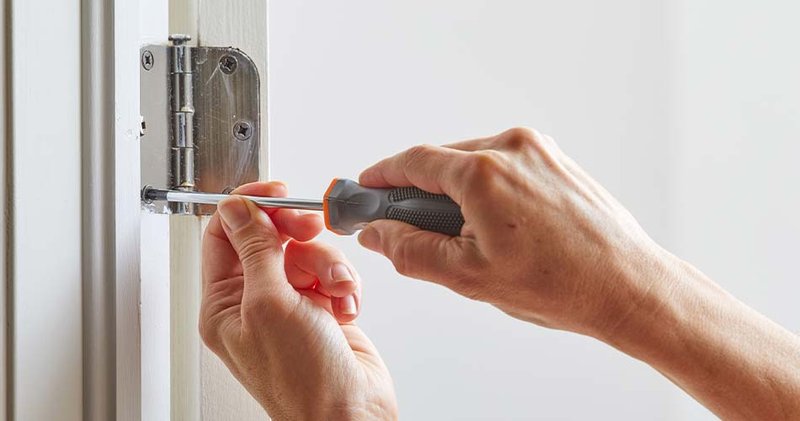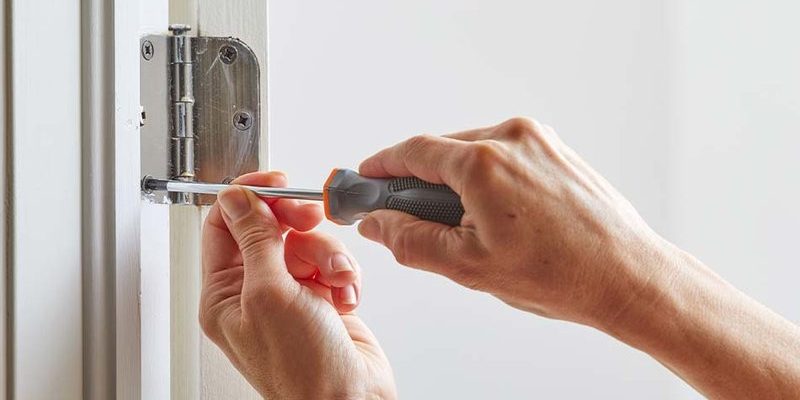
When a door hinge is misbehaving, it can lead to all sorts of problems. The door may scrape against the frame, create gaps, or even become difficult to close. Understanding how to troubleshoot this issue can save you time and money, particularly if you’re not ready to call a handyman. Let’s take a look at the potential causes behind a door hinge that isn’t holding the door straight and how you can effectively fix it.
Identifying the Problem
First things first: you need to identify what’s causing your door hinge to go rogue. Is it simply loose screws, or is the hinge itself damaged? Honestly, start by observing the door in its closed position. Check for any gaps between the door and the frame. If you see uneven spaces, that’s often a telltale sign that something is off.
Sometimes, it might be as simple as a few loose screws. If the hinge seems to jiggle when you move the door, that might be your culprit! On the other hand, if the hinge looks rusted or bent, you may need to replace it altogether.
Here’s a quick checklist to help you pinpoint the issue:
- Are the screws on the hinge tight?
- Is there any visible damage to the hinge?
- Does the door swing freely without resistance?
- Is the door warped or misaligned?
Taking the time to observe these elements will save you a lot of headaches later down the road.
Tools You’ll Need
Before you dive into fixing the problem, let’s gather some basic tools you’ll need. Having everything on hand makes the process smoother. Here’s what I recommend:
- A screwdriver (flathead or Phillips, depending on your screws)
- A level to check for alignment
- A measuring tape for precise adjustments
- Wood glue or putty (for warped doors)
- A replacement hinge if necessary
With these tools at your disposal, you’re well-equipped to tackle the issue effectively. It’s like having a toolbox of superpowers! You don’t want to start fixing a door hinge only to find you’re missing your trusty screwdriver.
Tightening the Screws
One of the most common problems with door hinges is loose screws. Over time, constant use can cause screws to loosen, which affects the hinge’s ability to hold the door straight. Here’s the good news: tightening screws is a simple task!
1. Grab your screwdriver. Make sure it fits the screws on your hinge.
2. Check each screw on the hinge. Turn the screwdriver clockwise until the screws are snug. Don’t overdo it; you don’t want to strip them.
3. Check the door alignment. After tightening, open and close the door a few times to see if it’s now aligned properly.
If the door still isn’t behaving, it may need some further adjustments.
Replacing or Realigning the Hinge
If tightening screws doesn’t fix the problem, you might have to take a closer look at the hinge itself. Perhaps it’s damaged or bent, which often means it’s time for a replacement. Here’s how to approach this:
1. Remove the old hinge. Use your screwdriver to take it off, noting how it was originally positioned.
2. Install the new hinge. Align the new hinge in the same position as the old one and fasten it securely.
3. Test the door. After installing, check the alignment again. Open and close the door to ensure it sits straight in the frame.
If you find that your door still isn’t aligned, it might also be the door itself causing the issue—especially if you notice a warping effect.
Dealing with a Warped Door
Sometimes a door becomes warped due to humidity, age, or temperature fluctuations. A warped door can affect how the hinge functions and its alignment. Here’s how to manage this:
1. Assess the warping. Close the door and look for gaps. Use a level to see how uneven the door is.
2. Apply heat or moisture. For minor warping, applying gentle heat from a hairdryer can help. Alternatively, applying moisture (but not too much) can also relax the wood.
3. Reinforce with glue or putty. If the door has a significant warp, you might need to use wood glue or putty to help reshape it. Once set, recheck the alignment again.
While you’re taking these steps, keep in mind the weather conditions in your area. Extreme humidity or dry spells can cause repeated warping, so consider this while troubleshooting.
Adding Shims for Extra Support
If you’re still struggling with alignment, adding shims can help. Shims are small pieces of material that can correct the door’s positioning. Here’s how to add them:
1. Identify the hinge that needs support. Most often, it’s the top hinge that needs adjusting.
2. Loosen the screws slightly. Don’t remove them completely, just enough to create space.
3. Insert the shim. Slide a shim behind the hinge to lift it slightly.
4. Tighten the screws back up. Check the alignment, and you may need to adjust or add shims to achieve the desired level.
Using shims is like giving your door a little boost, helping it stand tall and proud again!
Preventative Maintenance Tips
Now that you’ve tackled the troubleshooting, let’s keep those hinges in good shape. Preventative maintenance can extend the lifespan of both your door and its hinges. Here are a few tips:
1. Regularly check screws. Make it a habit to inspect screws every few months. A quick check can save you future headaches.
2. Lubricate hinges. A little lubrication goes a long way. Use a door hinge lubricant to keep everything moving smoothly, which also helps prevent rust.
3. Avoid slamming doors. This might seem simple, but avoiding slamming helps your hinges last longer. Gentle use is key!
By incorporating these habits, you ensure that your door hinges remain functional and reliable.
To wrap things up, troubleshooting a door hinge that’s not holding the door straight doesn’t have to be a daunting task. With a few tools, a little knowledge, and some patience, you can easily identify and fix common issues. Whether it’s tightening screws, replacing the hinge, or adding shims, the key is to take it step-by-step. A well-functioning door hinge can make a world of difference, keeping your home running smoothly.
So, the next time you notice that pesky door hanging just a little off-kilter, you’ll be equipped to handle it like a pro. Happy fixing!
